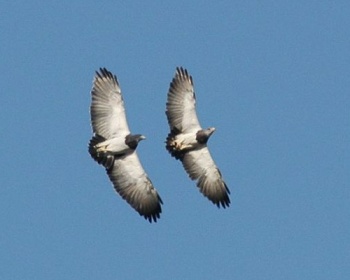(Picture of juvenile. References updated) |
(→External Links: Multiple GSearches combined) |
||
| (6 intermediate revisions by 2 users not shown) | |||
| Line 1: | Line 1: | ||
| − | [[Image:Black-chested_Buzzard_Eagle.jpg|thumb|550px|right|Photo by {{user|Fritz73|Fritz73}}<br />Alumine, Neuquen, [[Argentina]], Jannuary 2004]] | + | [[Image:Black-chested_Buzzard_Eagle.jpg|thumb|550px|right|Photo © by {{user|Fritz73|Fritz73}}<br />Alumine, Neuquen, [[Argentina]], Jannuary 2004]] |
;[[:Category:Geranoaetus|Geranoaetus]] melanoleucus | ;[[:Category:Geranoaetus|Geranoaetus]] melanoleucus | ||
==Identification== | ==Identification== | ||
| − | + | [[Image:Black-chested buzzard-eagle2.jpg|thumb|300px|right|Immature<br />Photo © by {{user|Luis+R|Luis R}}<br />Chacabuco. Metropolitan Region Santiago, [[Chile]], July 2018]] | |
| + | 60-76 cm (23½-30 in) Female larger | ||
*White underparts with fine blackish stripes | *White underparts with fine blackish stripes | ||
*Dark grey upperparts with a blackish, brownish or bluish hue | *Dark grey upperparts with a blackish, brownish or bluish hue | ||
| Line 11: | Line 12: | ||
'''Immature''': tail is not nearly as short as in adults; deep brown upperparts, lacks light wing patch; white or light buff underparts, heavy dark streaks on breast, dark bars on belly and thighs. Full adult plumage is acquired at 4-5 years old. | '''Immature''': tail is not nearly as short as in adults; deep brown upperparts, lacks light wing patch; white or light buff underparts, heavy dark streaks on breast, dark bars on belly and thighs. Full adult plumage is acquired at 4-5 years old. | ||
==Distribution== | ==Distribution== | ||
| − | |||
[[South America]]: found in [[Venezuela]], [[Colombia]], [[Ecuador]], [[Peru]], [[Bolivia]], [[Chile]], [[Argentina]], [[Paraguay]], [[Uruguay]], and [[Brazil]]. | [[South America]]: found in [[Venezuela]], [[Colombia]], [[Ecuador]], [[Peru]], [[Bolivia]], [[Chile]], [[Argentina]], [[Paraguay]], [[Uruguay]], and [[Brazil]]. | ||
==Taxonomy== | ==Taxonomy== | ||
| + | [[Image:Black-chested_Buzzard_Eagle_flight.jpg|thumb|350px|right|Female (on left) and male<br /> Photo © by {{user|Rodrigo+Reyes|Rodrigo Reyes}}<br />[[La Campana National Park]], [[Chile]], May 2007]] | ||
====Subspecies==== | ====Subspecies==== | ||
There are 2 subspecies<sup>[[#References|[1]]]</sup>: | There are 2 subspecies<sup>[[#References|[1]]]</sup>: | ||
| Line 23: | Line 24: | ||
A variety of habitats, in open and mountainous areas. | A variety of habitats, in open and mountainous areas. | ||
==Behaviour== | ==Behaviour== | ||
| − | [[Image:Black-chested Buzzard-Eagle | + | [[Image:Black-chested Buzzard-Eagle Tafe del Valle.jpg|thumb|350px|right|Juvenile<br />Photo © by {{user|Stanley+Jones|Stanley Jones}}<br />North of Tafí del Valle, Tucumán Province, [[Argentina]], October 2019]] |
====Diet==== | ====Diet==== | ||
The diet includes mid-sized mammals and birds. | The diet includes mid-sized mammals and birds. | ||
| Line 29: | Line 30: | ||
The large stick nest is constructed in high trees or on rocky cliffs. The clutch of 1-3 eggs is incubated for 28 days. | The large stick nest is constructed in high trees or on rocky cliffs. The clutch of 1-3 eggs is incubated for 28 days. | ||
==References== | ==References== | ||
| − | #{{Ref- | + | #{{Ref-Clements6thAug19}}#Avibase |
#AvianWeb | #AvianWeb | ||
| − | # | + | #BirdForum Member observations |
{{ref}} | {{ref}} | ||
| + | |||
==External Links== | ==External Links== | ||
*[http://www.arthurgrosset.com/sabirds/black-chestedbuzzard-eagle.html Arthur Grosset's Birds] | *[http://www.arthurgrosset.com/sabirds/black-chestedbuzzard-eagle.html Arthur Grosset's Birds] | ||
| − | {{GSearch|Geranoaetus | + | <br /> |
| + | <br /> | ||
| + | {{GSearch|"Geranoaetus melanoleucus" {{!}} "Black-chested Buzzard-Eagle"}} | ||
| + | {{GS-checked}}1 | ||
| + | <br /> | ||
| + | <br /> | ||
[[Category:Birds]][[Category:Geranoaetus]] | [[Category:Birds]][[Category:Geranoaetus]] | ||
Latest revision as of 19:50, 28 March 2023
- Geranoaetus melanoleucus
Identification
60-76 cm (23½-30 in) Female larger
- White underparts with fine blackish stripes
- Dark grey upperparts with a blackish, brownish or bluish hue
- Dark breast
- Ash-grey and white area on wings
- Very short black tail
Female: rufous tint to both the upper and underwing secondaries
Immature: tail is not nearly as short as in adults; deep brown upperparts, lacks light wing patch; white or light buff underparts, heavy dark streaks on breast, dark bars on belly and thighs. Full adult plumage is acquired at 4-5 years old.
Distribution
South America: found in Venezuela, Colombia, Ecuador, Peru, Bolivia, Chile, Argentina, Paraguay, Uruguay, and Brazil.
Taxonomy
Subspecies
There are 2 subspecies[1]:
- G. m. australis: smaller, white with fine dark barring below
- Andes of western Venezuela to Tierra del Fuego
- G. m. melanoleucus:
Habitat
A variety of habitats, in open and mountainous areas.
Behaviour
Diet
The diet includes mid-sized mammals and birds.
Breeding
The large stick nest is constructed in high trees or on rocky cliffs. The clutch of 1-3 eggs is incubated for 28 days.
References
- Clements, J. F., T. S. Schulenberg, M. J. Iliff, S. M. Billerman, T. A. Fredericks, B. L. Sullivan, and C. L. Wood. 2019. The eBird/Clements Checklist of Birds of the World: v2019. Downloaded from http://www.birds.cornell.edu/clementschecklist/download/
- Avibase
- AvianWeb
- BirdForum Member observations
Recommended Citation
- BirdForum Opus contributors. (2024) Black-chested Buzzard-Eagle. In: BirdForum, the forum for wild birds and birding. Retrieved 17 June 2024 from https://www.birdforum.net/opus/Black-chested_Buzzard-Eagle
External Links
GSearch checked for 2020 platform.1







